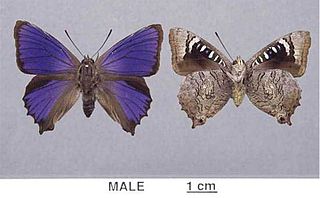
Odonata is an order of flying insects that includes the dragonflies and damselflies.

Entomology is the scientific study of insects, a branch of zoology. In the past the term insect was less specific, and historically the definition of entomology would also include the study of animals in other arthropod groups, such as arachnids, myriapods, and crustaceans. This wider meaning may still be encountered in informal use.

Somatochlora, or the striped emeralds, is a genus of dragonflies in the family Corduliidae with 42 described species found across the Northern Hemisphere.

The Platycnemididae are a family of damselflies. They are known commonly as white-legged damselflies. There are over 400 species native to the Old World. The family is divided into several subfamilies.

The Protoneuridae are a family of damselflies. Most species are commonly known as threadtails, while others are commonly known as bambootails.
The Megapodagrionidae are a family of damselflies, commonly called flatwings for their habit of spreading out the hind wings horizontally when at rest.

Ogyris is an Australasian genus of butterflies in the family Lycaenidae.

Argiolestinae is a subfamily of damselflies. They belong to the flatwing damselfly family, Argiolestidae. Like their relatives but unlike damselflies of other families, they usually spread their hindwings horizontally when resting. It is the largest subfamily in Argiolestidae, making up almost three-quarters of the family's species, found primarily in Australia, New Guinea, and New Caledonia.
Ocybadistes knightorum is a butterfly in the family Hesperiidae, first described in 1994 by Trevor A. Lambkin and John F. Donaldson. It is endemic to New South Wales. It has a very limited distribution in the Boambee area. The IUCN Red List lists Ocybadistes knightorum as an endangered species, because of its limited known distribution, and its habitat under threat from weed invasion, sea-rise and continued development. The butterflies are restricted to coastal grassy open-forest areas, that are usually next to mangroves.

Diphlebia euphoeoides, sometimes spelled Diphlebia euphaeoides, known as the tropical rockmaster, is an Australian species of broad winged damselfly. It is one of a group known as the azure damselflies. It is found in Queensland (Australia) and Papua New Guinea. It typically occurs near lakes, waterfalls or streams at relatively low altitudes, and is occasionally seen near dry pools.
Stephen John Brooks FRES is a British entomologist working at the Natural History Museum, London.

Ceriagrion aeruginosum is a species of damselfly in the family Coenagrionidae. Its common name is redtail. It is found in Indonesia, the Moluccas, New Guinea, Australia and possibly the Solomon Islands.

Chorismagrion is a monotypic genus of damselflies belonging to the family Synlestidae. The single species of this genus, Chorismagrion risi, known as a pretty relict, is a slender, medium-sized damselfly, mostly black in colour with white markings. It is endemic to north-eastern Australia, where it inhabits streams and large pools in rainforests.

Aciagrion fragilis is a species of damselfly in the family Coenagrionidae, commonly known as a blue slim. It is a small, slender damselfly, the male is blue and black. It has been recorded from northern Australia, New Guinea and the Lesser Sunda Islands in Indonesia, where it inhabits still waters and swamps.

Austroagrion exclamationis is a species of damselfly in the family Coenagrionidae, commonly known as a northern billabongfly. It is a small damselfly; the male is blue and black. It has been recorded from New Guinea and northern Australia, where it inhabits streams and still water.

Austrolestes minjerriba is an Australian species of damselfly in the family Lestidae, commonly known as a dune ringtail. It is found in coastal areas of northern New South Wales and southern Queensland where it inhabits acidic dune lakes and swamps.

Lestoidea barbarae is a species of Australian damselfly in the family Lestoideidae, commonly known as a large bluestreak. It has only been recorded from the vicinity of Wooroonooran National Park, in north-east Queensland, where it inhabits streams in rainforest.

Episynlestes intermedius is a species of Australian damselfly in the family Synlestidae, commonly known as an intermediate whitetip. It is endemic to the Eungella area of Queensland, where it inhabits streams.

Episynlestes cristatus is a species of Australian damselfly in the family Synlestidae, commonly known as a tropical whitetip. It is endemic to north-eastern Queensland, where it inhabits streams in rainforest.

Palaiargia ernstmayri is a species of broad-winged damselfly in the family Platycnemididae. The species is endemic to the Arfak Mountains of New Guinea, with only four observations to date.
















